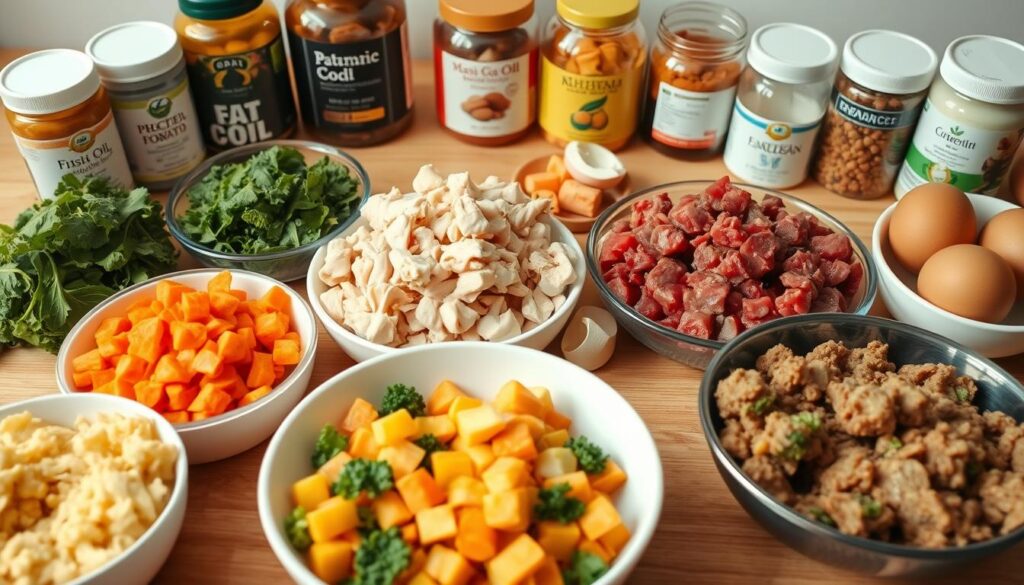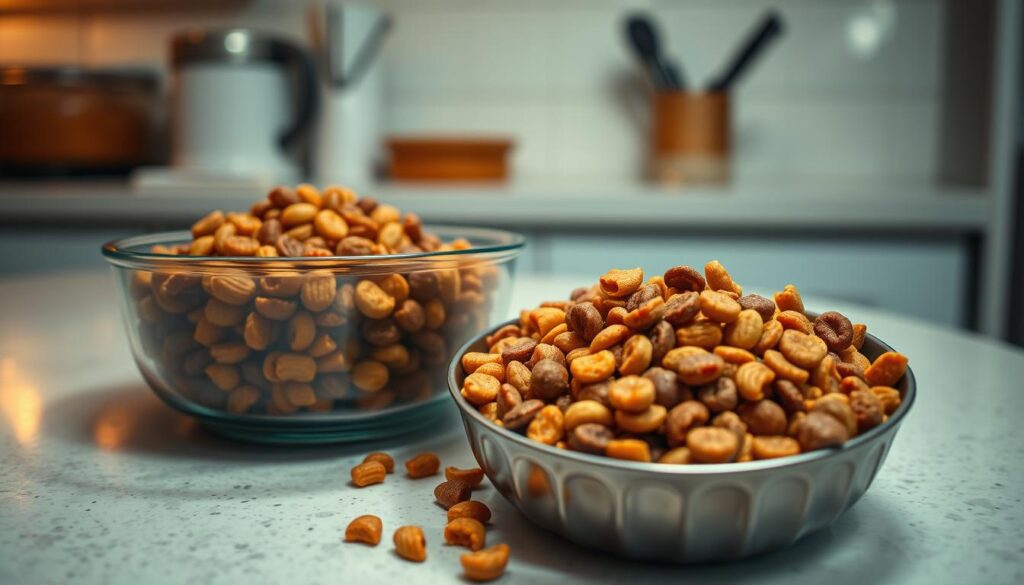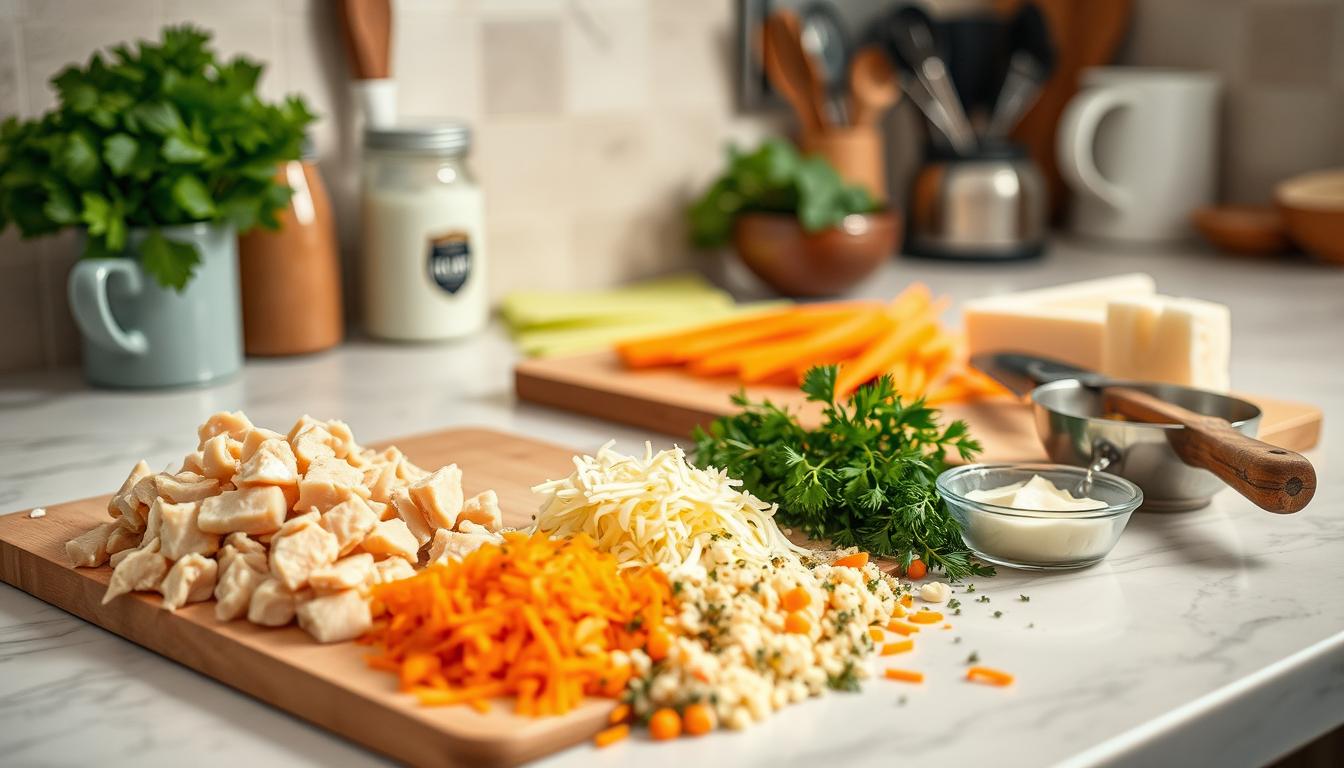It’s very important to give your cat a healthy diet. This helps them stay well. Now, cat owners can make their own veterinarian-recommended food.
First, know what your cat’s nutritional needs are. This helps make tasty, healthy meals. A good diet keeps your cat happy and healthy.
We’ll show you how to make homemade cat food. You’ll learn how to make meals that fit your cat’s needs.
Key Takeaways
- Understanding the nutritional needs of your cat is crucial.
- A well-balanced diet can help prevent health issues.
- Veterinarian-recommended recipes ensure a healthy diet.
- Homemade cat food allows for customization.
- Nutritional needs vary based on age, health, and lifestyle.
Understanding Your Cat’s Nutritional Needs
A cat’s diet is very important for their health. They need a lot of protein from animal sources. This is because cats are meat-eaters.
Essential Nutrients for Cats
Cats need special nutrients found in meat. Taurine is important for their heart. Arachidonic acid helps with many body functions. Without these, cats can get very sick.
They also need vitamins A and D, and minerals like calcium and phosphorus. These keep their skin, coat, eyes, and body working right.
Common Nutritional Deficiencies
Cats can miss out on important nutrients. A lack of vitamin A can cause skin and eye problems. Not enough calcium can hurt their bones.
Knowing about these missing nutrients is key when making homemade cat food. This way, your cat gets the nutrients they need.
The Importance of Protein
Protein is very important for cats. They need it from animal sources like chicken, salmon, or beef. This keeps them healthy.
Protein helps with muscle repair and growth. So, it’s important to make sure your cat eats enough protein.
Benefits of Homemade Cat Food
Homemade cat food can improve digestive health. Many commercial cat foods have fillers and by-products. These can cause diarrhea or constipation in cats.
By making your cat’s meals at home, you can pick ingredients that are better for their stomach.
Improved Digestive Health
Homemade cat food lets you choose good protein sources and carbs. This can help with digestion problems. For example, adding pumpkin or sweet potatoes can help with bowel movements.
Better Control Over Ingredients
With DIY cat food, you control what goes in. This means no preservatives, additives, or low-quality stuff. It’s great for cats with food allergies or sensitivities.
Cost-Effectiveness
Homemade cat food might seem pricey at first. But it can save money in the long run. Buying ingredients in bulk and planning meals can cut costs. Plus, a healthy diet means fewer vet visits, saving you money.
In short, homemade cat food has many benefits. It improves digestion, lets you control what’s in the food, and can save money. By picking the right ingredients and recipes, your cat can live a healthier, happier life.
Safety First: Guidelines for Homemade Recipes
When making food for your cat, safety is key. Some ingredients can harm them. So, it’s important to plan carefully and pay attention to details.
Avoiding Toxic Ingredients
Some foods are bad for cats. For example, onions and garlic can hurt their blood. Grapes and raisins can cause kidney problems. And chocolate is toxic because of theobromine.
As a cat owner, knowing these dangers is crucial. Make sure to check any new food before giving it to your cat.
Food Handling Safety Tips
Handling food right is important to keep it safe. Here are some tips:
- Wash your hands well before and after touching your cat’s food.
- Use clean tools and containers to avoid mixing things up.
- Keep homemade cat food in sealed containers in the fridge or freezer.
- Mark containers with the date so you use the oldest first.
By following these tips, you can make sure your cat’s food is safe and healthy. Veterinarians say, “food safety is key for your cat’s health.”
“A healthy cat needs a balanced and safe diet. Paying attention to what you add and how you handle it can make great meals for your cat.”
Essential Ingredients for Cat Recipes
Choosing the right ingredients for homemade cat food is key. It affects your cat’s health and happiness. The quality of these ingredients matters a lot.

High-Quality Proteins
Cats need a lot of animal proteins because they are meat eaters. High-quality protein sources are chicken, salmon, and beef. These proteins help muscles and keep the body working right.
Make sure to pick named proteins like chicken or turkey. This ensures your cat gets the best protein.
Healthy Fats and Carbohydrates
Fats give cats energy and keep their skin and fur healthy. Healthy fat sources are fish oil and chicken fat. They have omega-3 fatty acids. Carbs like brown rice and oats, and veggies like sweet potatoes, add fiber and energy.
Vitamins and Minerals
Vitamins and minerals are very important for your cat’s health. They help with immune function and bone health. Essential vitamins are Vitamin A, D, and B vitamins. Important minerals are calcium, phosphorus, and potassium. A balanced mix of these is crucial for your cat’s health.
By using these key ingredients in your cat food, you can give your cat a healthy diet.
Easy Homemade Cat Food Recipes
Making healthy food for your cat is simple. Just a few ingredients can make tasty, nutritious meals. Your cat will love it.
Here are some easy recipes to start with. They’re not just yummy. They also have lots of nutrients for your cat’s health.
Chicken and Rice Delight
This recipe is full of protein and carbs for your cat. You’ll need:
- 1 pound boneless, skinless chicken breast or thighs
- 1 cup cooked white or brown rice
- 1/4 cup finely chopped carrots
- 1/4 cup green beans
Mix everything together and serve.
Tuna and Pumpkin Treats
This recipe is rich in omega-3 fatty acids and fiber. You’ll need:
- 1 can of tuna in water, drained and flaked
- 1/2 cup cooked pumpkin
- 1/4 cup finely chopped parsley
Mix all the ingredients together and serve as a treat.
Beef and Sweet Potato Mix
This recipe is a great source of protein and complex carbs. You’ll need:
- 1 pound ground beef
- 1 medium sweet potato, cooked and diced
- 1/4 cup finely chopped green beans
Mix all the ingredients together and serve.
Here’s a comparison of the nutritional value of these recipes:
| Recipe | Protein | Fat | Carbohydrates |
|---|---|---|---|
| Chicken and Rice Delight | 35% | 20% | 45% |
| Tuna and Pumpkin Treats | 30% | 25% | 45% |
| Beef and Sweet Potato Mix | 40% | 30% | 30% |
These easy homemade cat food recipes are great for your cat’s health. They use simple, healthy ingredients. Your cat will love the meals.
Customizing Recipes for Special Needs Cats
Every cat is unique, and they need special food for health. Some cats need special food because of health issues, age, or lifestyle.
Recipes for Weight Management
Cats with weight problems need a special diet. High-protein, low-carb recipes help them lose weight and keep muscle.
- Use lean proteins like chicken or turkey
- Incorporate low-carb vegetables like green beans or broccoli
- Avoid fillers and high-carb ingredients
| Ingredient | Weight Management Benefit |
|---|---|
| Lean Chicken | High protein, low fat |
| Green Beans | Low in carbs, rich in fiber |
| Salmon | Rich in omega-3 fatty acids, supports overall health |
Options for Sensitive Stomachs
Cats with sensitive stomachs need easy-to-digest food. Gentle ingredients like cooked rice, pumpkin, and lean proteins help.
- Cooked rice and boiled chicken for a simple, easily digestible meal
- Pumpkin puree to support healthy digestion
- Avoid common allergens like beef or dairy
Age-Specific Nutritional Needs
Cats need different foods at different ages. Kittens need more protein and calories for growth. Older cats need fewer calories and more joint support.
| Life Stage | Nutritional Needs |
|---|---|
| Kitten | High protein, high calorie |
| Adult | Balanced diet for maintenance |
| Senior | Lower calorie, joint support |
By making your cat’s diet fit their needs, you help them stay healthy and happy.
Vet-Recommended Recipe Modifications
To make sure your cat eats well, you need to change homemade recipes based on vet advice. Talking to a vet is key to making a diet plan that fits your cat’s needs.
How to Adapt Recipes
Changing recipes means knowing your cat’s health, age, and how active they are. For example, older cats need less food but more support for their joints. On the other hand, younger, more active cats need more protein.
Your vet can tell you what changes to make based on regular check-ups.
When you change recipes, think about these things:
- Your cat’s health and any medical issues
- Age and life stage (kitten, adult, senior)
- Lifestyle (indoor vs. outdoor, activity level)
- Preferences and sensitivities
Incorporating Supplements
Adding supplements can also help. Vets often suggest omega-3 fatty acids for skin and coat health, probiotics for digestion, and vitamin D for overall health.
But, always talk to your vet before adding supplements. They can tell you the right type and amount for your cat.
By working with your vet and adjusting your cat’s food, you can help them stay healthy and happy.
Balancing Homemade Diets with Store-Bought Food
Mixing homemade and store-bought cat food can add variety. It also makes sure your cat gets all the nutrients they need. Homemade food has many benefits, but sometimes store-bought is easier or needed.
It’s good to mix these diets for your cat’s health. Let’s see how to do it well.
When to Mix and Match
There are times when mixing homemade and store-bought food is smart. For example, when you’re traveling, store-bought food is handy. If you’re really busy, adding commercial food can be a quick fix.
Here are some situations where mixing both can be beneficial:
- When you’re traveling or away from home
- If you’re experiencing a busy period with limited time for cooking
- To provide variety in your cat’s diet
- To gradually transition your cat to a new diet
Finding a Good Balance
Finding the right mix of homemade and store-bought food is key. You need to know what your cat needs and watch their health. Choose high-quality store-bought food that goes well with your homemade recipes.
| Diet Type | Benefits | Considerations |
|---|---|---|
| Homemade Cat Food | Customizable to cat’s needs, potentially lower cost | Time-consuming, requires nutritional knowledge |
| Store-Bought Cat Food | Convenient, nutritionally balanced | May contain preservatives, less customizable |
| Balanced Mix | Offers variety, combines benefits of both | Requires careful planning to ensure nutritional balance |

Knowing when to mix homemade and store-bought cat food helps. You can make a diet that’s balanced and varied. Always talk to your vet to make sure your cat’s diet is right.
Storage and Shelf Life of Homemade Cat Food
Homemade cat food needs careful handling and storage. This keeps its nutrients good. It also makes sure it’s safe for your cat.
Proper Storage Techniques
To keep homemade cat food fresh, follow these tips:
- Put food in airtight containers to stop freezer burn and keep it fresh.
- Write the date on containers.
- Keep it in the fridge at 40°F (4°C) or freeze at 0°F (-18°C) or below.
Refrigeration vs. Freezing: Use the fridge for food that’s good for a few days. Freeze it for longer. Frozen food lasts months, but use it in 3-4 months for best taste.
| Storage Method | Duration | Notes |
|---|---|---|
| Refrigeration | 3-5 days | Keep in airtight containers. |
| Freezing | 3-4 months | Use airtight, freezer-safe containers or freezer bags. |
Signs of Spoilage
Even with good storage, homemade cat food can spoil. Check for signs before feeding it to your cat. Look for:
- Unusual smells or slime.
- Mold or visible bacteria.
- Changes in texture or color.
If unsure, throw it away. Spoiled food can harm your cat’s health. So, be careful.
Transitioning your Cat to Homemade Food
Switching to homemade cat food can make your cat healthier. It’s a big change, but you can do it slowly. This way, your cat won’t get upset stomachs. We’ll show you how to make the switch easy for your cat.
Tips for a Smooth Transition
Begin by adding a little homemade food to their old food. Slowly add more homemade food over 7-10 days. This lets their body get used to the new food.
Watch how your cat eats and feels while changing their food. If they get sick, go back to adding more old food slowly. Make sure the homemade food has all the nutrients your cat needs.
Monitoring Your Cat’s Health
After your cat gets used to homemade food, keep an eye on them. Watch their weight and how much energy they have. Take them to the vet regularly to make sure they’re doing well.
If your cat acts differently or gets sick, talk to your vet. They can help figure out what’s wrong and fix it. Keeping a food diary helps you remember what you’ve fed your cat. It can help find problems.
Frequently Asked Questions about Cat Nutrition
It’s important to know the truth about cat food. Many cat owners believe myths that can harm their pets. These myths can lead to health problems.
Common Myths About Cat Diets
One big myth is that cats only eat meat. While cats do need meat, they also need some veggies and grains. This mix is key to a balanced diet.
- Myth: Cats need to eat raw meat to stay healthy.
- Fact: Some cats do well on raw diets, but not all. A good cooked diet can give them everything they need.
- Myth: Cats can get all the moisture they need from dry food.
- Fact: Cats should drink water and eat moist foods. This helps keep them hydrated.
How to Know if Your Cat is Thriving
Watching your cat’s health is key to knowing if they’re doing well. Here are signs they’re thriving:
| Health Indicator | Signs of Good Health |
|---|---|
| Coat Condition | Shiny, smooth, and free of excessive shedding |
| Energy Levels | Active, playful, and shows interest in surroundings |
| Weight | Maintains a healthy weight, not too thin or overweight |
| Appetite | Eats regularly and shows enthusiasm for meals |
Knowing the truth about cat food helps you make better choices. If you’re not sure, always talk to a vet.
Resources for Cat Owners
Being a cat owner means knowing about cat food. There are many places to learn how to feed your cat right.
Recommended Reading
Want to learn more about cat food? Check out “The Cat: Clinical Medicine and Surgery.” It’s full of info on cat health. Also, “Cat Nutrition: The Complete Guide” is great for learning about what cats need to eat.
Online Communities
Online forums are great for talking to other cat owners. Sites like Reddit’s r/catowners and the Catster forum are perfect. You can share tips and learn from others about cat food.
FAQ
What are the essential nutrients for cats?
Cats need lots of protein from meat. They also need vitamins and minerals. Cats must eat animal products to live.
How can I ensure my homemade cat food is balanced?
Use many ingredients like good proteins, fats, and carbs. Add vitamins and minerals too. Talk to a vet to make sure it’s right.
Are there any ingredients I should avoid in homemade cat food?
Yes, avoid onions, garlic, and chocolate. Also, don’t use low-quality or allergy-causing foods.
Can I mix homemade cat food with store-bought food?
Yes, mixing is good for variety. Choose quality store food and balance it with homemade.
How do I store homemade cat food to maintain its quality?
Store it right with portions, fridge, and freezer. Watch for spoilage signs like bad smells or sliminess.
How can I transition my cat to a homemade diet?
Do it slowly and watch your cat’s health. This helps avoid upset stomachs.
What are some common myths about cat diets?
Some think cats are easy to feed or can eat plants. But cats need specific foods for health.
How can I know if my cat is thriving on their current diet?
Check their energy, coat, and stool. A vet can also give good advice.




